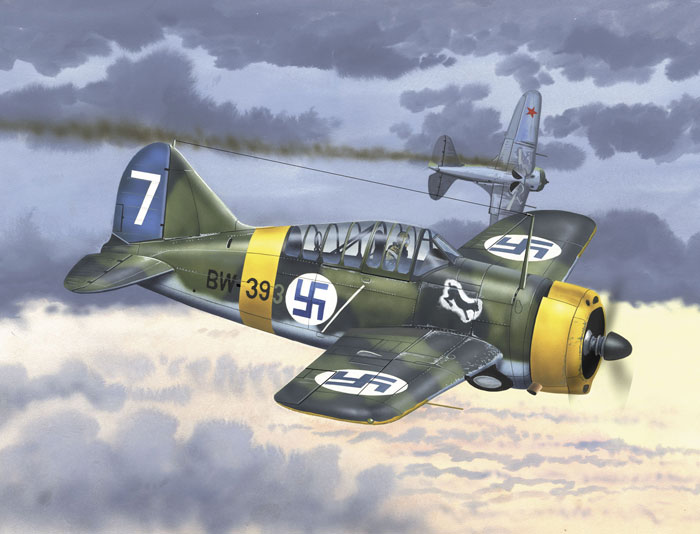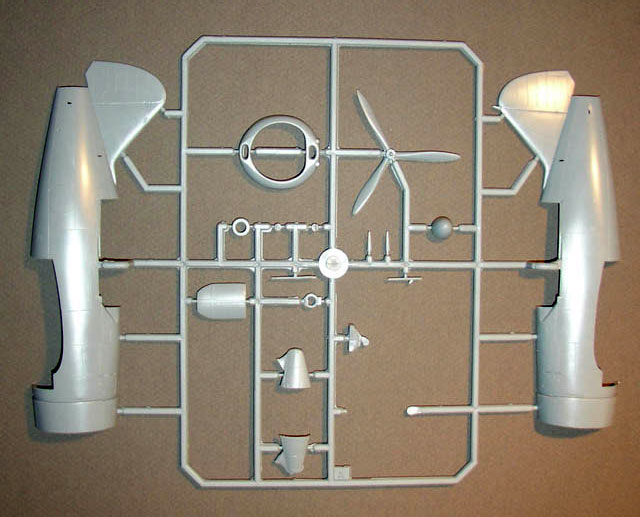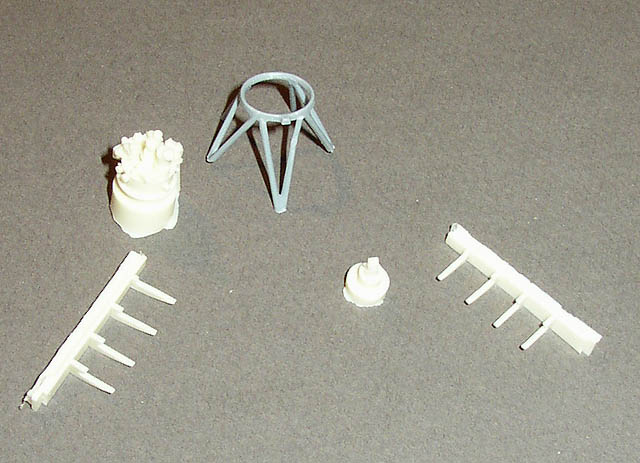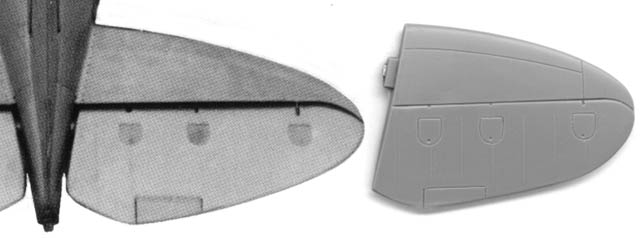|
Brewster F2A-1
and
Finnish Model 239

Classic Airframes
S
u m m a r y
|
| Catalogue Number: |
Classic Airframes Kit No. 4100 -
Brewster F2A-1
Classic Airframes Kit No. 4101 - Finnish Model 4101 |
| Scale: |
1/48 |
| Contents and Media: |
Three sprues of gray styrene, one sprue of clear
styrene, resin and photo etched parts. Instructions, decal sheet and
painting guide (see details below). |
| Price: |
MSRP
USD$45.00 |
| Review Type: |
Another Look |
| Advantages: |
Conforms to published plans; fine panel lines,
extensive detail; busy wheel wells and clever engine mounting; excellent
markings |
| Disadvantages: |
|
| Recommendation: |
Recommended |
Reviewed by Jim Maas

Classic
Airframes' 1/48 scale Brewster F2A-1 and Model 239
may be ordered online from Squadron
You can read Jim’s historical background of
the Brewster F2A-1 / Model 239 in the Reference Library
by
following this link.
[Two disclaimers – I was involved in the
development of this kit. On the other hand, I am also anal-retentive
about Buffalos, so it should average out…]
Tamiya’s Buffalo has been with us for more than thirty years in 1/48
scale, but it cannot be used for a Finnish aircraft. Tamiya’s offering
represents a later version, much like the difference between a Bf-109B
and 109E. Every couple of months, there would be a posting on HyperScale
looking for various conversions to retrofit the Tamiya kit to the
earlier variant. These can now stop.
Classic Airframes is releasing two versions: the Finnish Model 239 and
the U.S. Navy F2A-1 from which it was derived.
The kit contains three frames of injection parts, with fine scribed
details, and one frame of clear parts including appropriate windscreen,
canopy and ventral window options.

Click the thumbnails
below to view larger images:
Also supplied is a small bag of resin bits
including wing well interior spars and the rear portion of the Cyclone
engine, and a photo etched fret with alternate instrument panels,
seatbelts, wiring harness, RDF loops, gunsights and bomb racks and bomb
fins.

Decals pertain to each release: U.S. Navy
for the F2A-1 kit and a copious sheet of Finnish markings for the Model
239 boxing.
The first thing that struck me about this
kit was the amazing feat of molding achieved with the engine mount. Yes,
there is a complete structural interior for the gear well - a cat’s
cradle of struts supporting the engine while accommodating the gear
retraction mechanism. The kit even provides accurate forward and rear
bulkheads and the rear section of the engine, which protruded into the
landing gear bay. Reference to the Squadron ‘In Action’ book will show
that some wiring and tubing can be added to taste, but this kit
authoritatively addresses the gear well ‘black hole’.
Close examination of the plastic parts shows that the mold makers have
paid careful attention to detail. The tailwheel opening has the correct
‘keyhole’ shape created by the F2A-1’s barrier guide. Depending on
version, the differences between the U.S. and Finnish variants are
addressed. For the Navy type, the life raft container under the rear
canopy allows the builder to depict the octagonal RDF loop correctly, by
shaping the photo etched piece over an angled frame. The Finnish release
provides both the booted early tailwheel and the later, larger pneumatic
type that was more suitable for land-based operations. The F2A-1 offers
the telescopic gunsight and windscreen to match; the Model 239 release
had the unpierced windscreen with both ring-and-bead and Revi-type
gunsights used by the Finns. Also provided is a blanking plate for the
Finnish variant, used to replace the ventral window on aircraft in late
1941.
The bottom wing, as you can see in the photo, is a one-piece
carry-through part, insuring correct dihedral.

Be sure to clear any flash from the shell
ejection slots (one under each wing gun and one on the port wing, just
aft of the wing gear well). For both versions, fill and sand out the
landing light hole on the starboard wing undersurface – only the British
Model 339E had two landing lights, and you can draw your own conclusions
that the molding provides for both…. By the way, the kit properly shows
the characteristic ‘washout’ of the lower surface wingtips, common on
late 1930’s U.S. designs like the P-38, P-39, and P-40. You may need to
make an effort to maintain this feature when gluing the upper and lower
wing parts together since the plastic seems rather springy.
The fuselage parts accurately shows the carbon monoxide vents on the
rear fuselage just below the tail (on later F2A/339 versions, these
vents were moved to the rear portion of the ventral window). For those
of you using the Kagero Brewster F2A Buffalo book as a reference, please
not that the kit locations are correct – the Kagero drawings have these
vents too far aft.
The kit’s exterior detail even extends to
the relief tube vent on the lower fuselage under the port wing.
Cockpit interior is extensive between
plastic and photo etched components, even to the point of different
panels for the two variants. My first reaction to the control column was
“what’s that hot dog on a curved stick?” but in fact factory drawings
show the control column is quite contoured.
The Finnish spade-shaped head armor is
included on the Model 239 seat; a normal Navy seat is included for the
F2A-1.
A very nice touch is the way the
four-legged rollover pylon is molded in two halves; this avoids the
frequently broken part seen in other Buffalo models.
The tailplanes have locator tabs to help
with fit, although some flash removal may be necessary. The elevators
seem to have a bit too much chord near the trim tabs, and the inboard
side should be more rounded.
|
 |
|
Although the photo is
not a direct overhead shot, the rear contour of the elevator can
compared to the kit part |
You may wish to separate the elevators while working on them, since
parked Brewsters commonly showed the elevators deflected down.
The major components compare favorably with several published plans for
the F2A-1/239, with one or two provisos. Seen from the side, the depth
of the lower cowling matches the Kagero book. It is shallower than that
shown in the Avions Le Brewster Buffalo by Jean-Louis Couston, but
noticeably deeper when compared to plans drawn by Finnish expert Pentti
Manninen. I intend to shave a little depth off the bottom of the cowling
but it’s not major drawback. For Buffalo purists, a little fiddling with
the rear canopy may be in order. The bottom line of the rear canopy
actually follows the fuselage stringer lines, so there is a subtle
downward curve toward the rear – but only noticeable if you compare it
to the bottom line of the sliding canopy.
Kit No. 4100 - F2A-1
Markings for the U.S. Navy release provide
for each of the nine F2A-1’s that served with VF-3, at least as they
were initially received – later remarking within the squadron resulted
in BuNo 1396 being remarked as ‘3-F-1’ with red section leader striping,
but this variation can be made by re-combining the kit decals.
The kit instructions also point out the
12-inch black anti-glare panel leading from the windscreen to the
cowling; while not included as a decal, any quarter-inch wide black
striping will do. Also included is an all-gray F2A-1 stationed at NAS
Norfolk in 1941, the last remaining F2A-1, since the remainder were
remanufactured as F2A-2’s.
Although not provided by the kit (since
there’s no way it could have been!) the Navy F2A-1 can also serve to
depict the wild Barclay disruptive color schemes which the Navy tried,
and sensibly dropped, in 1940.
Click the thumbnails below
to view color marking guides for this kit:
Kit No. 4101 - Finnish Model 239
The Finnish release provides markings for
nine different aircraft, ranging from delivery aircraft in overall
aluminum lacquer, green and black wartime birds, and even a post-war
Brewster with white-blue-white roundels.
Click the thumbnails below
to view color marking guides for this kit:
The Finnish markings options represent a
great deal of research by Classic Airframes’ crack Decal Division,
ranging from the latest research on correct undersurface colors to
accurate Finnish beer bottle emblems, used as victory markings by
Finnish ace Eino Luukkanen.
The serial numbers for later Finnish
aircraft are accurately given in a combination of black and camouflage
green, so try to match your upper surface camouflage green to the decal
color for a correct representation.
The Classic Airframes F2A-1 and Model 239
kits fill a noticeable gap in 1/48 scale modeling. Along with the many
other color schemes the kits make possible, it is now possible to build
an accurate model of Finnish BW-393, the aircraft which scored more
victories than any other aircraft on record.*
Classic Airframes’ well detailed kits provide for excellent
representations of these historically significant airplanes.
These are really nice kits.
Recommended.
* BW-393 had 41 victories scored,
with a variety of pilots. The Finns, making do with what they had,
didn't have the luxury of replacing aircraft, so they performed amazing
feats of repair and rehab. Other air forces would have simply junked an
aircraft with 'x' many flight hours and put a new airframe into
service. Reportedly, the 'most kills of any airframe' achievement of
BW-393 was recognized by the Guinness Book of Records folks some years
back ( see
http://heninen.net/brewster/english.htm third paragraph down), and
I've certainly never seen any counter claim.
Thanks to
Classic Airframes for
the review sample.
Classic Airframes
kits are available worldwide through hobby retailers and from
Squadron.com
Review and Images Copyright © 2005 by Jim Maas
Page Created 09 May, 2005
Last updated 09 May, 2005
Back to HyperScale Main Page
Back to Reviews Page
|
Home | What's
New | Features
| Gallery |
Reviews | Reference
| Forum
| Search